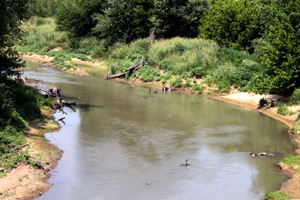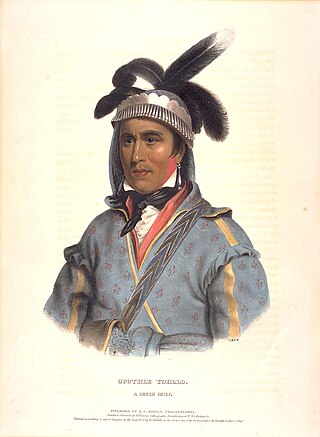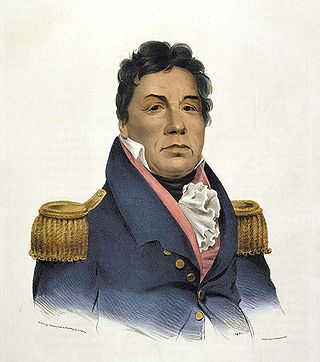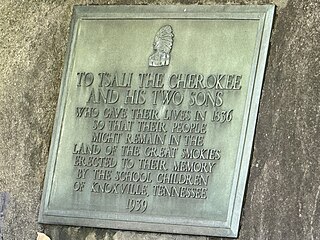
The Muscogee, also known as the Mvskoke, Muscogee Creek or just Creek, and the Muscogee Creek Confederacy, are a group of related Indigenous peoples of the Southeastern Woodlands in the United States. Their historical homelands are in what now comprises southern Tennessee, much of Alabama, western Georgia and parts of northern Florida.

The Battle of Tippecanoe was fought on November 7, 1811, in Battle Ground, Indiana, between American forces led by then Governor William Henry Harrison of the Indiana Territory and tribal forces associated with Shawnee leader Tecumseh and his brother Tenskwatawa, leaders of a confederacy of various tribes who opposed European-American settlement of the American frontier. As tensions and violence increased, Governor Harrison marched with an army of about 1,000 men to attack the confederacy's headquarters at Prophetstown, near the confluence of the Tippecanoe River and the Wabash River.

Tecumseh was a Shawnee chief and warrior who promoted resistance to the expansion of the United States onto Native American lands. A persuasive orator, Tecumseh traveled widely, forming a Native American confederacy and promoting intertribal unity. Even though his efforts to unite Native Americans ended with his death in the War of 1812, he became an iconic folk hero in American, Indigenous, and Canadian popular history.

The Creek War was a regional conflict between opposing Native American factions, European powers, and the United States during the early 19th century. The Creek War began as a conflict within the tribes of the Muscogee, but the United States quickly became involved. British traders and Spanish colonial officials in Florida supplied the Red Sticks with weapons and equipment due to their shared interest in preventing the expansion of the United States into regions under their control.

Tecumseh's War or Tecumseh's Rebellion was a conflict between the United States and Tecumseh's confederacy, led by the Shawnee leader Tecumseh in the Indiana Territory. Although the war is often considered to have climaxed with William Henry Harrison's victory at the Battle of Tippecanoe in 1811, Tecumseh's War essentially continued into the War of 1812 and is frequently considered a part of that larger struggle. The war lasted for two more years, until 1813, when Tecumseh and his second-in-command, Roundhead, died fighting Harrison's Army of the Northwest at the Battle of Moraviantown in Upper Canada, near present-day Chatham, Ontario, and his confederacy disintegrated. Tecumseh's War is viewed by some academic historians as the final conflict of a longer-term military struggle for control of the Great Lakes region of North America, encompassing a number of wars over several generations, referred to as the Sixty Years' War.

The Shawnee are a Native American people of the Northeastern Woodlands. Their language, Shawnee, is an Algonquian language.

Tenskwatawa was a Native American religious and political leader of the Shawnee tribe, known as the Prophet or the Shawnee Prophet. He was a younger brother of Tecumseh, a leader of the Shawnee. In his early years Tenskwatawa was given the name Lalawethika, but he changed it around 1805 and transformed himself from a hapless, alcoholic youth into an influential spiritual leader. Tenskwatawa denounced the Americans, calling them the offspring of the Evil Spirit, and led a purification movement that promoted unity among the Indigenous peoples of North America, rejected acculturation to the American way of life, and encouraged his followers to pursue traditional ways.

John Ridge, born Skah-tle-loh-skee, was from a prominent family of the Cherokee Nation, then located in present-day Georgia. He went to Cornwall, Connecticut, to study at the Foreign Mission School. He met Sarah Bird Northrup, of a New England Yankee family, and they married in 1824. Soon after their return to New Echota in 1825, Ridge was chosen for the Cherokee National Council and became a leader in the tribe.
The Battle of Chustenahlah was fought in Osage County, Oklahoma, on December 26, 1861, during the American Civil War. A band of 9,000 pro-Union Native Americans was forced to flee to Kansas in bitter cold and snow in what became known as the Trail of Blood on Ice.

The Battle of Chusto-Talasah, also known as Bird Creek, Caving Banks, and High Shoal, was fought December 9, 1861, in what is now Tulsa County, Oklahoma during the American Civil War. It was the second of three battles in the Trail of Blood on Ice campaign for the control of Indian Territory during the American Civil War.

The Battle of Round Mountain was the first battle in the Trail of Blood on Ice campaign for the control of Indian Territory during the American Civil War that occurred on November 19, 1861. Its main purpose was to prevent Union supporters of the Creek Nation, led by Opothleyahola from fleeing Indian Territory to the protection of Union forces in Kansas.

Opothleyahola was a Muscogee Creek Indian chief, noted as a brilliant orator. He was a Speaker of the Upper Creek Council and supported traditional culture.
Peter McQueen was a chief, prophet, trader and warrior from Talisi He was one of the young men known as Red Sticks, who became a prophet for expulsion of the European Americans from Creek territory and a revival of traditional practices. The Red Sticks attracted a majority of the population in the Upper Towns in the early nineteenth century. From open conflict with the Lower Towns in the Creek War, the Red Sticks were drawn into conflict with the United States after being attacked by territorial militia.

Pushmataha was one of the three regional chiefs of the major divisions of the Choctaw in the 19th century. Many historians considered him the "greatest of all Choctaw chiefs". Pushmataha was highly regarded among Native Americans, Europeans, and white Americans, for his skill and cunning in both war and diplomacy.
Big Warrior or Tustanagee Thlucco was a principal chief of the Muscogee Nation until his death on March 8, 1825. He was referred to as "one of the most powerful Creeks allied with the United States".

During the American Civil War, most of what is now the U.S. state of Oklahoma was designated as the Indian Territory. It served as an unorganized region that had been set aside specifically for Native American tribes and was occupied mostly by tribes which had been removed from their ancestral lands in the Southeastern United States following the Indian Removal Act of 1830. As part of the Trans-Mississippi Theater, the Indian Territory was the scene of numerous skirmishes and seven officially recognized battles involving both Native American units allied with the Confederate States of America and Native Americans loyal to the United States government, as well as other Union and Confederate troops.
Thlopthlocco Tribal Town is both a federally recognized Native American tribe and a traditional township of Muscogee Creek Indians, based in Oklahoma. The tribe's native language is Mvskoke, also called Creek.

Tsali was a noted leader of the Cherokee during two different periods of the history of the tribe. As a young man, Tsali joined the Chickamauga faction of the Cherokee in the late 18th century, and became a leader in the fight against the American frontiersmen and their constant expansion into tribal lands. Later In 1812, he became known as The Prophet, and urged the Cherokee to ally with the Shawnee warrior, Tecumseh, in war against the Americans. Two decades later, in what seemed a fulfilment of his earlier prophecy, he resisted the forced removal of the Native Americans from their mountainous, western North Carolina towns, and as a result, a large following of like-minded Cherokee gathered to him. Following Tsali's martyrdom, the three hundred fugitive followers of his that remained free after his sacrifice became the forebears of some 14,000 registered members of the Eastern Band of the Cherokee Indians living today in the Qualla Boundary.

Tecumseh's confederacy was a confederation of Native Americans in the Great Lakes region of North America which formed during the early 19th century around the teaching of Shawnee leader Tenskwatawa. The confederation grew over several years and came to include several thousand Native American warriors. Shawnee leader Tecumseh, the brother of Tenskwatawa, became the leader of the confederation as early as 1808. Together, they worked to unite the various tribes against colonizers from the United States who had been crossing the Appalachian Mountains and occupying their traditional homelands.
The family of Tecumseh, the Shawnee leader, has long been the subject of inquiry by historians. The documentary evidence of his personal life is fragmentary, with frequently contradictory evidence, and historians have often reached differing conclusions about significant details.













